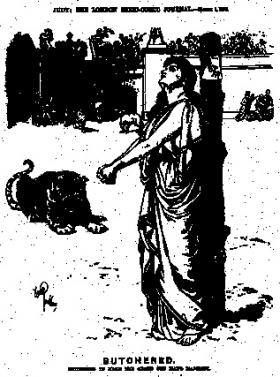Pigs, Paddies, prams and petticoats: Irish Home Rule and the British comic press, 1886–93
Published in 18th–19th - Century History, Features, Issue 1 (Jan/Feb 2005), Volume 13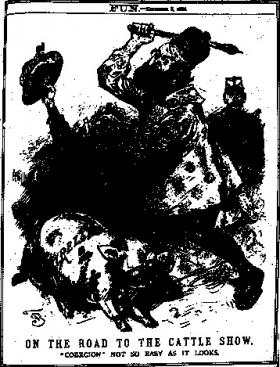 The Irish question was a constant source of concern and debate in the nineteenth-century British press, but perhaps never more so than in the mid-1880s and early 1890s, when almost every newspaper and journal offered extensive commentary on the first two Irish Home Rule bills. Comic weeklies such as Punch, Fun and Judy were no exception, and they offered a wide range of cartoons and commentary on Ireland and the Home Rule debate. Since they were ‘only joking’, Victorian political cartoonists could express anxieties and animosities that were often frowned upon in a society that prided itself on its progressive outlook, and they could portray Ireland and the Irish in a more bigoted fashion than would have been acceptable in serious periodicals.
The Irish question was a constant source of concern and debate in the nineteenth-century British press, but perhaps never more so than in the mid-1880s and early 1890s, when almost every newspaper and journal offered extensive commentary on the first two Irish Home Rule bills. Comic weeklies such as Punch, Fun and Judy were no exception, and they offered a wide range of cartoons and commentary on Ireland and the Home Rule debate. Since they were ‘only joking’, Victorian political cartoonists could express anxieties and animosities that were often frowned upon in a society that prided itself on its progressive outlook, and they could portray Ireland and the Irish in a more bigoted fashion than would have been acceptable in serious periodicals.
Relied on a body of shared truths and preconceptions
For a political cartoon to be funny it should deliver its bite or sting at first glance. This requires that the image draw from a collection of well-known and easily recognised symbols and that it contain some element of perceived truth. Although not all readers of Punch, Judy and the other comic weeklies shared the opinions or prejudices behind every joke, they understood the cartoons because they relied on a body of shared truths and preconceptions. This is precisely why editorial cartoons are such a valuable resource. By analysing them and discovering what made them intelligible and amusing, we can appreciate how traditional stereotypes and contemporary concerns informed popular perceptions of the Irish question and its proposed solutions in this critical period.
Numerous scholars have explored anti-Irish cartoons in the Victorian press, in particular those featuring dehumanised or simianised images of ‘Paddy’, the objectified Irishman. But Paddy was almost never alone in these drawings. Political cartoons commenting on the Irish question contained a number of characters, including John Bull, Britannia, British and Irish politicians, and Erin (the feminine representation of Ireland). Although portrayals of Paddy as a monster or the ‘Celtic Caliban’ have certainly garnered the most attention (then and now), these cartoons were always a minority of those touching on Ireland and the Irish question. In fact, after hitting a peak during the Land War of 1879–1882, the number of monstrous Paddies appearing in the comic press steadily declined. Throughout the Victorian age the vast majority of cartoons on Irish matters featured one or more of the other characters, and many of them expressed some compassion for Ireland or at least support for various Irish reform measures.
None of the comic newspapers openly supported Irish Home Rule in 1886–93, but some of them, notably Punch and Fun, did offer sympathy for Irish demands. Others, such as Judy, were openly hostile and expressed their disapproval with cruel lampoons of the Irish and Prime Minister William Gladstone. In both cases, however, the comic 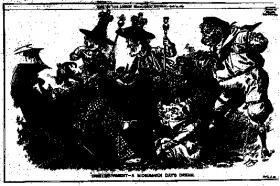 papers relied on a collection of stereotypes and symbols traditionally used to represent Ireland and Irishness. The Irish people and their political leaders were commonly portrayed as pigs, peasants, comely maidens, terrorists, mental patients and children. Whether they were used to express opposition to or support for Irish reform, these images ultimately reinforced long-standing prejudices about the people of Ireland and undercut their claims for self-government.
papers relied on a collection of stereotypes and symbols traditionally used to represent Ireland and Irishness. The Irish people and their political leaders were commonly portrayed as pigs, peasants, comely maidens, terrorists, mental patients and children. Whether they were used to express opposition to or support for Irish reform, these images ultimately reinforced long-standing prejudices about the people of Ireland and undercut their claims for self-government.
These cartoons also reflected some of the dominant beliefs and concerns about the prospect of Irish self-government shared by the British press and public. In 1886 the majority of the British press, particularly the London papers, opposed Gladstone’s Irish Home Rule bill. The degree of opposition and specific complaints varied with each newspaper, but there were several widespread criticisms that consistently appeared in newspaper leaders, or editorials, as well as in the pages of the comic press. First and foremost among these was the charge that Gladstone’s Home Rule bill would ultimately destroy the Union of Great Britain and Ireland, and perhaps the British Empire as well. The same newspapers also held that the Irish people, or at least a majority of them, were not yet suited for any substantial self-government. In fact, the argument ran, most Irish men and women had no interest in Home Rule. Only a small minority of professional agitators and their Irish-American paymasters were interested in restoring an Irish parliament. And, despite their protestations to the contrary, the British papers maintained that the Irish nationalists and their supporters in America would never be content until they made Ireland a completely independent republic. Without real legislative oversight from Westminster and the Irish nationalists in control, many newspapers maintained, home-ruled Ireland would quickly become a centre of disorder and sedition that threatened the peace and security of Britain. Finally, some writers, particularly those working for conservative newspapers, vehemently opposed abandoning the loyal Protestant minority of Ulster to what they believed was certain oppression at the hands of the nationalists and Catholic clergy.
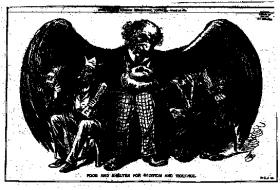 The pig
The pig
Pigs were frequently used to represent Ireland or Irish politicians from at least the 1840s, but they became especially prominent in the last quarter of the century. The pig represented Ireland’s status as an agricultural, rustic and backward nation, as well as the Irish peasantry’s supposed indifference to filth and muck. Paddy’s reputed ignorance made him an easy target for demagogic politicians and Fenians. The island’s reliance on agriculture dictated that it remain a junior partner in a political and economic union with industrialised Britain. This nearly universal conception of Ireland as an agricultural country was further reinforced by the Irish nationalists’ own celebration of the rural west and Irish pastoral values.
During the Home Rule era and the following decades the comic Irish pig had several recurring roles. The first of these was the carnival, or trick, pig. In these cartoons British or Irish politicians attempted to teach an Irish pig to spell or to perform some other stunt. But for every trained pig there was also a naughty Irish pig that disobeyed the commands of its driver. This theme was very popular and perhaps one of the longest-running representations of Irish politics in the Victorian era. It was first used in the mid-1840s when Punch lampooned Daniel O’Connell’s difficulties with the Young Ireland movement and reappeared regularly into the next century. During the Home Rule era most of the drivers were British politicians. In Fun’s ‘On the Road to the Cattle Show’ (18 February 1893) [page 42] Lord Salisbury finds that coercion is ‘not so easy as it looks’ as the muzzled Irish pig runs circles around him. Like most Liberal newspapers, Fun was a consistent critic of coercive security policies in Ireland, especially when applied by Tory governments. While criticising the Tories, however, this cartoon also reinforces traditional ideas of the Irish as disorderly and lawless.
In many cartoons the pig was not assigned an active role and merely served as a cipher for the rural and agricultural Irish nation. In several cartoons during the Land War and between 1886 and 1893 the Irish pig was a beast that Gladstone attempted to charm by playing some appealing ‘Irish melody’ on his Scottish pipes. In Judy’s ‘Dismemberment—A Midsummer Day’s Dream’ (3 August 1887) [page 43] the Irish pig appears with the other four nations of the United Kingdom. In this cartoon the Grand Old Man dreams away while the representatives of the ‘Celtic Fringe’ wear crowns and look on lovingly. John Bull, now a triple amputee, appears much less pleased. This cartoon repeated the frequent claims by critics that the proposed granting of Irish self-government was the first step to the destruction of the empire. Although the majority of the Irish parliamentary party claimed to be satisfied with Gladstone’s Home Rule bills, no one in the opposition press believed them and instead firmly maintained that an Irish republic would invariably follow. As Ireland went, critics prophesied, so would India and then the rest of Britannia’s overseas possessions. As The Times averred on 13 May 1886, any arguments in favour of Irish Home Rule were also ‘good for abandoning India and for throwing up the whole cares and duties of Empire’.
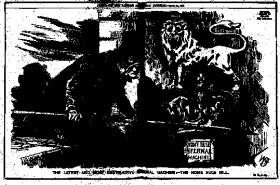 Paddy and Mr Gladstone
Paddy and Mr Gladstone
The most common comic representation of the Irish, in British or American comic newspapers, was Paddy, the Irish peasant. Paddy was typically depicted wearing breeches, a shabby or patched coat, and a distinctive hat, usually with a clay pipe in its band. Paddy was assumed to be lazy, credulous, excitable, and irrationally hostile to lawful authority. His supposed ignorance provided fodder for countless jokes, some of which continue to circulate even today. Although he dressed like Paddy, the Irish rebel or Irish-American Fenian was depicted with more brutish features. At best he had a more pronounced jaw and at worst he appeared as an ape-like or completely dehumanised figure, signifying his degraded nature, though again this representation was becoming rather rare by the late 1880s. The cartoon Irish or Irish-American rebel was also typically distinguished by his mask and the assorted weapons he carried. In Judy’s ‘Food and Shelter for Sedition and Violence’ (30 March 1887) [page 43] Gladstone is a mother hen whose chicks include a Fenian bandit. All of Gladstone’s ministries were marked by the introduction of significant Irish bills, and all of these were characterised by the conservative press as improper rewards for Irish disloyalty and sedition.
Although the Irish question often demanded solutions that blurred traditional political or ideological divides, there were some long-standing differences between the Liberal and Conservative parties in their approach to Ireland. Perhaps the most important of these was the argument of conciliation versus coercion. In short, Conservative newspapers and political figures demanded the establishment of order and security in Ireland before passing any reform measures. Their Liberal colleagues often posited instead that gestures of reconciliation and justice were the quickest path to peace in Ireland.
The Paddy treatment was not reserved for the Irish peasantry or Fenians alone: most of the leading members of the Irish Parliamentary Party were depicted as Paddies or brigands at one time or another. On a few occasions, even the prime minister was ‘Paddified’, usually with considerable comic effect. Perhaps the best example is Judy’s ‘The Latest and Most Destructive Infernal Machine’ (21 April 1886) [page 44], in which the prime minister, dressed as an Irish peasant, uses a pike marked ‘revolution’ to lower a ‘home rule infernal machine’ beneath the British crown. Although Judy and other papers critical of Gladstone’s Irish policies presented him as a clown, a charlatan, a quack doctor and so forth, he was rarely drawn as anything but a man. Punch in particular was a fairly consistent supporter of Gladstone and his Irish policy, and even though the paper could not openly endorse Irish self-government, it made clear that it believed the prime minister’s motivations in securing ‘justice for Ireland’ to be honourable.
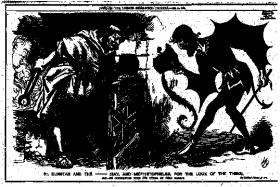 Parnell
Parnell
While Gladstone’s humanity was never in doubt, the same could not be said for Charles Stewart Parnell, whose visage was stock-in-trade for editorial cartoonists and a burning subject for British journalists between 1880 and his premature death in 1891. Although the most hostile Parnell cartoons were published during the Land War, he was also dehumanised in several cartoons in the Home Rule period. One of the best-known examples of this is ‘The Irish “Vampire”’ (24 October 1885), which appeared in Punch a few months before the first Home Rule bill was introduced. This cartoon features a National League vampire bat with Parnell’s head hovering over a prostrate Erin. It repeated a long-standing charge that Parnell and his party were little better than professional agitators who preyed on their gullible countrymen. According to this argument, the Parnellites only sought an Irish parliament so that they might continue to suck the lifeblood out of Ireland without interference from Britain. In Judy’s ‘St Dunstan and the ——’ (30 December 1885) [page 44] the leader of the Irish party appears as a shamrock-clad Mephistopheles. However, John Bull/St Dunstan readies his tongs to grab him by the nose, as in the old fable. As devilish as Parnell might appear and act, this cartoon suggests that he was never too much for John Bull to handle.
Despite these cartoons, it would be fair to say that British press opinion on Parnell, like the Irish question in general, was decidedly mixed. Widely vilified during the Land War and the years leading up to the first Home Rule bill, Parnell was celebrated and welcomed into the Liberal fold during his ‘union of hearts’ with Gladstone (1886–91). Many newspapers excoriated Parnell as a parliamentary commission was formed in 1888 to examine his purported connection with the grisly Phoenix Park assassinations of 1882. But he then received considerable sympathy when the most damning pieces of evidence against him, letters connecting him to the murderers, were revealed as forgeries. If few British papers openly mourned his death in 1891, the vast majority, including the comic weeklies, offered respectful if restrained commentary. This division of opinion on the ‘uncrowned king’ of Ireland was readily apparent to contemporaries, as evidenced by Fun’s ‘The Parnell Peep Show’ (26 February 1890) [page 45]. A young Johnny Bull looks into a peep-show that depicts Parnell as both felon and martyr. When he asks ‘Showman Smith’ which one is Mr Parnell, he is told ‘whichever you please . . . you pays yer money and you takes yer choice’.
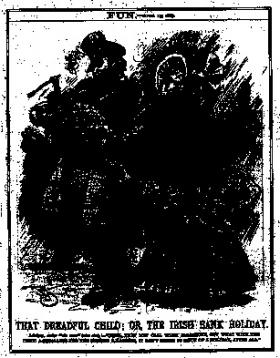 The Irish child
The Irish child
Another long-running comic theme popular in the Home Rule era was the Irish child. Ireland, like the other nations of the empire, was essentially viewed as a dependant—a responsibility and burden borne by the British people and government with great trouble and little reward. Britannia and John Bull were guardians whose task it was to oversee the political, social and moral education of their wards. In the case of Ireland, it was hoped that this education would eventually lead to Anglicisation and the island’s full and equal participation in the United Kingdom. In Fun’s ‘That Dreadful Child; or the Irish Bank Holiday’ (13 April 1887) [page 45] a squawking Irish baby demands immediate attention, ruining the holiday of Lord Salisbury and Britannia. In this and similar cartoons Ireland is presented as an unequal member of the family, but one that demands extraordinary care and attention. By demanding so much of his political parents the Irish child distracts them from more important adult matters, such as governing the millions who belonged to the empire.
In addition to Ireland itself, various Irish bills were represented as children whom the prime minister sought to protect or put to bed by securing their passage through parliament. Judy’s ‘Too Strong and Not Strong Enough’ (9 June 1886) [above] includes two rather precocious Irish child-bills complete with clay pipes, bottle and blunderbuss, the standard symbols of Irishness. This cartoon expresses the conservative Judy’s pleasure that Gladstone’s heave on the Liberal party shaft has broken and splintered it, leaving the tightly joined granite blocks of the Union intact. In this and many other cartoons the Irish were drawn as children not only to affirm their social and political immaturity but also to consciously deny them the prospect of self-government. Guardianship implied not only a superior status but also a duty that could not be laid aside. In other words, Britain could not grant Ireland Home Rule any more than a parent could leave an infant to fend for itself.
Erin
After Paddy, the most common symbol of Ireland in the late nineteenth century was Erin. Erin was typically portrayed in one of two ways: as a young maiden saved from various dangers by William Gladstone or John Bull, or as a strong and independent figure that British politicians attempted to charm and seduce. In this way she represented both wings of Irish policy—coercion and conciliation. Coercive measures were passed not only to combat sedition and jail Irish and Irish-American rebels but also to protect the Irish majority, represented by Erin. At the same time, it was quite obvious to most members of the press and political classes that this same majority often seemed discontented or estranged from British law and morality. Like Erin, they needed to be properly courted so that they might become full and willing partners in the marital/political union with Britain.
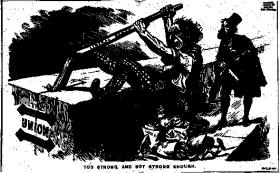 In previous decades John Bull and others protected Erin against a range of menacing Paddies and Calibans. In the late 1880s her nemesis was a skulking Home Ruler who sought to steal her away from John Bull and rule her as his own wife. In these cartoons Erin was typically portrayed as a modest but attractive peasant maid, while John Bull or the prime minister might appear in military garb. Erin tended to don more fashionable dress when she received the advances of British politicians. Printed in February 1886, when the press brimmed over with rumours and speculation about the Grand Old Man’s plans for Ireland, Fun’s ‘Asking His Intentions’ (24 February 1886) [page 47] presents the ‘O’Gladstone’ as a dandyish suitor confronted by a sceptical Mrs Bull. He coyly informs Erin’s guardian that he has plenty of ‘intintions’, but ‘just at prisint I don’t know quite exactly what they are’. Fun was a consistent champion of Gladstone and his Irish reform measures in the past, but like the rest of the press in February and March 1886 it became impatient to learn the details of Gladstone’s Irish scheme, which he finally unveiled in early April. Once Gladstone introduced his first Home Rule bill he won Erin’s heart and her allegiance, at least according to Fun. Between 1886 and 1893 the paper printed numerous cartoons in which Erin rejected rival suitors, such as Joseph Chamberlain or Salisbury, or appeared in an affectionate scene with her Grand Old Man.
In previous decades John Bull and others protected Erin against a range of menacing Paddies and Calibans. In the late 1880s her nemesis was a skulking Home Ruler who sought to steal her away from John Bull and rule her as his own wife. In these cartoons Erin was typically portrayed as a modest but attractive peasant maid, while John Bull or the prime minister might appear in military garb. Erin tended to don more fashionable dress when she received the advances of British politicians. Printed in February 1886, when the press brimmed over with rumours and speculation about the Grand Old Man’s plans for Ireland, Fun’s ‘Asking His Intentions’ (24 February 1886) [page 47] presents the ‘O’Gladstone’ as a dandyish suitor confronted by a sceptical Mrs Bull. He coyly informs Erin’s guardian that he has plenty of ‘intintions’, but ‘just at prisint I don’t know quite exactly what they are’. Fun was a consistent champion of Gladstone and his Irish reform measures in the past, but like the rest of the press in February and March 1886 it became impatient to learn the details of Gladstone’s Irish scheme, which he finally unveiled in early April. Once Gladstone introduced his first Home Rule bill he won Erin’s heart and her allegiance, at least according to Fun. Between 1886 and 1893 the paper printed numerous cartoons in which Erin rejected rival suitors, such as Joseph Chamberlain or Salisbury, or appeared in an affectionate scene with her Grand Old Man.
Although Erin almost always represented Catholic Ireland, opponents of Irish Home Rule used her on occasion to symbolise Ulster. Judy frequently echoed the mainstream newspapers’ complaints that the Home Rule bills threatened to sacrifice the most loyal and industrious portion of Ireland to the whims of a traitorous majority and their intolerant church. This sentiment is clear in Judy’s ‘Butchered’ (8 March 1893) [right], in which Ulster appears as a helpless Christian maiden thrown to the wild beasts for the 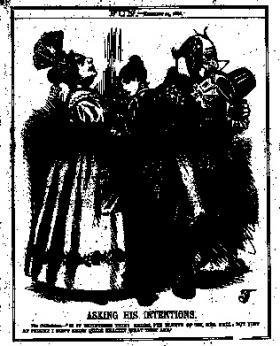 emperor’s (Gladstone’s) sport. The tigers and wolves stalk out of three tunnels marked ‘Parnellite’, ‘Anti-Parnellite’ and ‘Priests’. Like most conservative papers, Judy assumed that Home Rule would mean ‘Rome rule’ and thus the persecution of Ulster Protestants.
emperor’s (Gladstone’s) sport. The tigers and wolves stalk out of three tunnels marked ‘Parnellite’, ‘Anti-Parnellite’ and ‘Priests’. Like most conservative papers, Judy assumed that Home Rule would mean ‘Rome rule’ and thus the persecution of Ulster Protestants.
Conclusion
These cartoons help us to understand that the Home Rule bills of 1886 and 1893, like every major piece of Irish legislation, were never understood in a vacuum. These images were constructed and interpreted using a combination of old stereotypes and contemporary anxieties. While we can and should appreciate Victorian comics for their humour and artistic skill, we also need to regard them as important sources. Like any editorial cartoonist, the artists for Punch, Judy and Fun populated their drawings with well-established and immediately recognisable symbols of Ireland and Irishness in order to make their joke and political point. These symbols also reflected traditional anti-Irish prejudices that consistently placed Ireland and the Irish in an inferior position. As a result, even those comic newspapers that were generally supportive of Gladstone and his Irish policy expressed their opinions in a format that essentially denied the capacity of the Irish to govern themselves.
Michael de Nie is Assistant Professor of History at the State University of West Georgia, Carrollton.
Further reading:
L.P. Curtis, Jr, Apes and angels: the Irishman in Victorian caricature (Washington, 1997).
R. Douglas, L. Harte and J. O’Hara, Drawing conclusions: a cartoon history of Anglo-Irish relations, 1798–1998 (Belfast, 1998).
A. O’Day, Irish Home Rule, 1867–1921 (Manchester, 1998).
